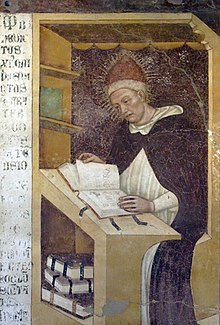
Back Pous Benedictus XI Afrikaans بندكت الحادي عشر Arabic بندكت الحداشر ARZ Бенедыкт XI Byelorussian Бенедикт XI Bulgarian Benead XI Breton Benet XI Catalan Gáu-huòng Benedictus 11-sié CDO Benedikt XI. Czech Pab Bened XI Welsh
Pope Blessed Benedict XI | |
|---|---|
| Bishop of Rome | |
 A 1352 fresco by Tommaso da Modena at the church of Saint Nicholas in Treviso | |
| Church | Catholic Church |
| Papacy began | 22 October 1303 |
| Papacy ended | 7 July 1304 |
| Predecessor | Boniface VIII |
| Successor | Clement V |
| Previous post(s) |
|
| Orders | |
| Ordination | 1300 |
| Consecration | March 1300 |
| Created cardinal | 4 December 1298 by Boniface VIII |
| Personal details | |
| Born | Nicola Boccasini 1240 Treviso, Italy |
| Died | 7 July 1304 (aged 63–64) Perugia, Papal States |
| Motto | Illustra faciem Tuam super servum Tuum (Latin for 'Let Your Face shine upon Your servant') |
| Coat of arms |  |
| Sainthood | |
| Feast day | 7 July |
| Beatified | 24 April 1736 Rome, Papal States by Pope Clement XII |
| Attributes |
|
| Patronage | Treviso |
| Other popes named Benedict | |
Pope Benedict XI (Latin: Benedictus PP. XI; 1240 – 7 July 1304), born Nicola Boccasini (Niccolò of Treviso), was head of the Catholic Church and ruler of the Papal States from 22 October 1303 to his death, in 7 July 1304.[1]
Boccasini entered the Order of Preachers in his native Treviso. He studied at Venice and Milan before becoming a teacher in Venice and in other Dominican houses. He served two terms as Provincial Prior of Lombardy, before being elected Master of the Order in 1296. Two years later he was made cardinal. He was appointed Bishop of Ostia, and served as papal legate first to Hungary, and then to France. He was with Pope Boniface VIII when Boniface was attacked by French forces at Anagni.
He was beatified with his cultus confirmed by Pope Clement XII in 1736. He is a patron of Treviso.
- ^ Conradus Eubel, Hierarchia catholica medii aevi I editio altera (Monasterii 1913), p. 13.